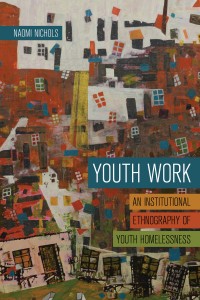 A new book by Postdoctoral Fellow and Faculty of Education grad Naomi Nichols (PhD '12) looks at the complicated institutional practices that govern both the lives of young people living in shelters and the workers who try to help them. Youth Work: An Institutional Ethnography of Youth Homelessness invites people who work in the human services to start thinking and acting beyond their own institutional accountability and to examine how their inability to communicate and to work effectively across sectors creates problems for young people who depend on a “system of care”.
A new book by Postdoctoral Fellow and Faculty of Education grad Naomi Nichols (PhD '12) looks at the complicated institutional practices that govern both the lives of young people living in shelters and the workers who try to help them. Youth Work: An Institutional Ethnography of Youth Homelessness invites people who work in the human services to start thinking and acting beyond their own institutional accountability and to examine how their inability to communicate and to work effectively across sectors creates problems for young people who depend on a “system of care”.
“I wrote this book to show how the things that young people do in institutions like schools are co-ordered or coordinated with the things that adult practitioners do in the same sites,” says Nichols. “Our inability to communicate and work effectively across sectors creates problems for young people whose livelihoods, health, and wellness depend on being able to get their needs met in a timely way through their encounters with mainstream institutions.”

Naomi Nichols
Nichols referenced her doctoral work on adolescence and the study of politics, democracy, and the public sphere to inform the book. The research for Youth Work took place in Ontario human service sector organizations (e.g., schools, Ontario Works social assistance, sexual health clinics, youth services, mental health services, police services, and child protective services) where youth are active. Nichols is a postdoctoral Fellow at the Canadian Observatory on Homelessness (formerly Canadian Homelessness Research Network) at York University.
“My research occurred in partnership with an emergency shelter for youth, and the bulk of my fieldwork took place there,” she says. “The research was not participatory, as I didn’t have the resources to pay youth or staff to join the project as researchers. It was, however, oriented to making change. I shared my findings with the Executive Director at the shelter as they emerged and we used the knowledge I was producing to create and fund a new program, hire new staff, and provide staff development opportunities. The experience of working in close partnership with the shelter for my doctoral studies fundamentally shaped the scholar that I am now. I went on to spend the next couple of years studying community-university research collaborations in order to improve the two sectors’ abilities to work effectively and equitably together. I feel like the youth sector in the small city where my research occurred provided me with my earliest training as a community-based researcher.”
The book provides an interesting insight into the concept of social justice through Nichols investigation of governance using the youth sector as a case study.
“Using the conceptual framework of Institutional Ethnography, Dr. Nichols research explored homelessness and shelter living from the perspective of the young people who lived there,” says Professor Alison Griffith, Nichols’ doctoral supervisor. “Based on her experience of working in a homeless shelter and talking to the young residents, Dr. Nichols ‘mapped’ the connections between their lived experience and the range of social service agencies with which they interacted – the homeless shelter, Children’s Aid Society, local schools, the police, and so on. She interviewed social workers, CAS workers, police officers, the Director of the homeless shelter, other shelter workers, and teachers working with these young people and responsible for their care. Her focus on the everyday work of her informants brought into view the textual coordination of social services (e.g. records kept to provide CAS funded beds in the homeless shelter, school attendance records required for receiving social welfare, shelter supervision policies and police routines). She was able to show how the young people often “fell through the cracks”; cracks constructed through the ordinary, but uncoordinated working practices of social professionals. Recognizing this dialogic model of the intersections between young people, social service professionals, and the texts that coordinate their communication is unique in the field of youth studies and education.”
The book is published by the University of Toronto Press.
